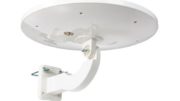I tested two High Gain/Low Noise UHF/VHF Amplifiers against a fairly normal good amp with 3.5 dB noise figure, this is my Reference Amplifier.
The Comm Scope SV-A15PRS was my cable TV amp, and the Reference Amplifier:
Comm Scope SV-A15PRS, 53 – 1000 MHz NF: 3.5 dB
The other amplifiers were:
- The Winegard LNA-200, L-VHF: 20dB NF: 3dB, H-VHF 15dB NF: 3dB, UHF: 16.5dB NF 1dB
- The Antennas Direct PA-18, HF: 18.6dB NF: 1.8dB, UHF: 15.4dB NF: 1.8dB max average
Because of the signals at this antenna location, I didn’t see enough differences between any of the amplifiers to make me want to use one or the other here, so I ended up leaving the reference amp in this location.
When I did a test with the SV-A15PRS Comm Scope vs. the PA-18 Antennas Direct on the attic antennas, there was a noticeable difference favoring the PA-18 Antennas Direct amplifier. I did not have a way to measure the difference at the time, but I noticed that the PA-18 Antennas Direct amp was better and so I left it in the attic and removed the SV-A15PRS Comm Scope amplifier.
As will be mentioned elsewhere, I have had problems with the attic antennas when the leaves are on all the trees between these antennas and the Washington, D.C., TV stations. Things improved after the 2013-14 winter ice storms that removed enough of the branches, and we had good TV reception all summer in 2014. This year, 2015, things were down about 3dB or so, and once I removed a signal splitter, the signals were once again solid. This will be explained more in a future blog article.
The table of the test data follows. A word about the reported test values: this table shows data to the first decimal value. I’ve left this, but in the future I will no longer bother with this level of detail because the signals in this area vary far too much. In the future, I will only be reporting the integer dB values and the lowest of those, so if the values vary from 45.5 to 47.2 dB within my time of view – generally about 20 seconds after I change channels and for 15 – 20 seconds of watching the numbers – I will only report the value as 45 dB.
Also, I noticed that some stations have what looks like excellent signal levels when looking at the dB values alone, but the signal can’t be decoded due to either excessive BER or poor S/N. So, if this is the case, in the future, the BER and S/N will be reported as well.
| Channel | SV-A15 | LNA-200 | SV-A15 | PA-18 | SV-A15 |
| 7 | 46.0 | 45.7 | 45.3 | 50.4 | 46.2 |
| 8 | 40.5 | 40.4 | 41.1 | 46.0 | 42.3 |
| 9 | 43.1 | 42.2 | 43.7 | 46.7 | 42.8 |
| 10 | 31.7 | 31.3 | 31.9 | 32.4 | 31.5 |
| 11 | 59.3 | 58.5 | 60.2 | 61.2 | 49.5 |
| 12 | 30.7 | 30.0 | 31.0 | 30.7 | 31.1 |
| 13 | 59.6 | 53.7 | 57.2 | 57.8 | 57.5 |
| 14 | 30.0 | 32.3 | 30.0 | 30.0 | 30.0 |
| 15 | 56.6 | 59.8 | 55.1 | 55.2 | 54.9 |
| 18 | 37.2 | 38.0 | 37.0 | 41.0 | 37.6 |
| 23 | 30.0 | 30.1 | 30.0 | 30.0 | 30.0 |
| 24 | 33.8 | 34.8 | 32.0 | 33.8 | 35.3 |
| 27 | 42.2 | 43.0 | 43.6 | 45.7 | 43.1 |
| 28 | 35.2 | 38.5 | 40.4 | 42.0 | 40.6 |
| 29 | 55.4 | 55.6 | 55.5 | 58.2 | 55.1 |
| 30 | 30.0 | 30.0 | 30.0 | 30.5 | 30.0 |
| 33 | 43.1 | 48.3 | 45.4 | 46.2 | 46.1 |
| 34 | 48.9 | 53.0 | 51.9 | 52.8 | 51.7 |
| 35 | 45.7 | 47.2 | 45.6 | 46.2 | 47.8 |
| 36 | 43.2 | 42.1 | 41.5 | 41.7 | 45.0 |
| 37 | 33.7 | 37.7 | 34.1 | 33.8 | 32.8 |
| 38 | 71.9 | 77.2 | 71.9 | 71.4 | 72.1 |
| 39 | 41.9 | 46.1 | 43.1 | 41.3 | 40.8 |
| 40 | 68.6 | 72.2 | 65.5 | 65.2 | 65.5 |
| 41 | 59.9 | 62.2 | 59.4 | 59.7 | 59.5 |
| 42 | 34.4 | 35.5 | 35.4 | 36.8 | 35.3 |
| 46 | 61.2 | 59.9 | 61.2 | 64.0 | 60.7 |
| 47 | 30.0 | 30.0 | 30.0 | 32.2 | 30.0 |
| 48 | 44.3 | 45.0 | 45.3 | 46.8 | 45.3 |
| 50 | 44.4 | 47.1 | 43.9 | 46.8 | 47.8 |
| L-VHF: 20dB NF: 3dB, H-VHF 15dB NF: 3dB, UHF: 16.5dB NF 1dB |
| VHF: 18.6dB NF: 1.8dB, UHF: 15.4dB NF: 1.8dB max average |





